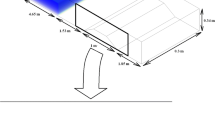Abstract
The results of numerical investigations of the problem of flow through a porous reservoir in the process of its water flooding with addition of a sediment-forming component are given. The mathematical model is based on the mass conservation laws for each of the considered phases and components supplemented with the equations of motion and constitutive relations necessary to close the system of equations. In solving the problem, an empirical dependence of the sediment formation intensity on the content of the sediment-forming component in the aqueous solution with allowance for variation in the effective porosity of the medium is used. The main features in solving the sediment-formation problem are distinguished using the empirical dependence and a contrastive analysis of the effect of choosing this dependence on the solution results is carried out. It is shown that the neglect of the experimental results in the mathematical formulation can lead to not only unjustified overestimated results in realizing the method but also give a distorted pattern of the entire process of sediment formation in fluid flow through a water-flooded porous reservoir.
Similar content being viewed by others
References
M. Musket, Physical Fundamental of the Oil Recovery Technology (Institute of Computer Research, Moscow, Izhevsk, 2004) [in Russian].
A.Sh. Gazizov and A.A. Gazizov, Enhancement of the Efficiency of Oil-Field Development Based on the Limitation of Motion of Water in Reservoirs (OOO Nedra-Biznestsentr, Moscow, 1999) [in Russian].
P.T. Zubkov and K.M. Fedorov, “Effect of Gel Plugs onWater and Oil Flow in a Nonhomogeneous Porous Reservoir,” Fluid Dynamics 30, No. 2, 238–244 (1995).
P.T. Zubkov and K.M. Fedorov, “Mechanism of Deep Gel Plugging Emplacement in a Nonhomogeneous Oil Reservoir,” Fluid Dynamics 29, No. 1, 76–80 (1994).
A.Kh. Mirzadzhanzade, M.M. Khasanov, and R.H. Bakhtizin, Studies on Simulation of Complex Oil Production Systems (Gilem, Ufa, 1999) [in Russian].
A.A. Barmin and D.I. Garagash, “Solution Flow in a Porous Medium with Impurity Adsorption,” Fluid Dynamics 29, No. 4, 516–527 (1994).
A.I. Nikiforov and D.P. Nikan’shin, “Particle Transfer by Two-Phase Flow through a Porous Medium,” Mat. Modelirovanie 10, No. 6, 42–52 (1998).
D.P. Nikan’shin and A.I. Nikiforov, “Simulation of Various-Size Particle Transfer by Two-Phase Flow through a Porous Medium,” Inzh.-Fiz. Zh. 73, No. 3, 497–500 (2000).
I.A. Charnyi, Underground Hydrogasdynamics (Gostoptekhizdat, Moscow, 1963) [in Russian].
E.V. Lozin and V.N. Khlebnikova, Use of Colloid Reactants for Enhancement of Oil Recovery (BashNIPIneft’, Ufa, 2003) [in Russian].
V.N. Nikolaevskii, K.S. Basniev, A.T. Gorbunov et al., Mechanics of Saturated Porous Media (Nedra, Moscow, 1970).
Additional information
Original Russian Text © G.R. Idrisova, L.A. Kovaleva, M.V. Mavletov, A.A. Musin, 2011, published in Izvestiya Rossiiskoi Akademii Nauk, Mekhanika Zhidkosti i Gaza, 2011, Vol. 46, No. 1, pp. 101–108.
Rights and permissions
About this article
Cite this article
Idrisova, G.R., Kovaleva, L.A., Mavletov, M.V. et al. Mathematical simulation of two-phase fluid flow through a water-flooded porous reservoir with sediment formation. Fluid Dyn 46, 90–96 (2011). https://doi.org/10.1134/S0015462811010108
Received:
Published:
Issue Date:
DOI: https://doi.org/10.1134/S0015462811010108




